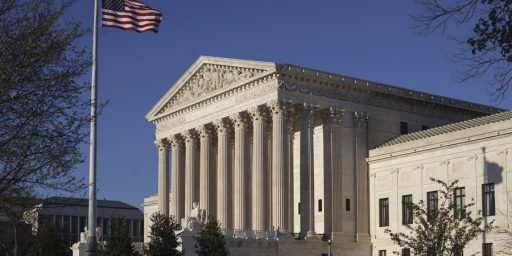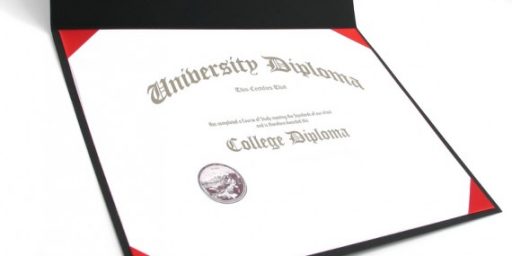VICTORY FOR DIVERSITY
Lee Bollinger, the former University of Michigan president who was the nominal defendant in the two suits yesterday, calls the decisions “a great victory for American higher education, and for the nation as a whole.” He is elated that states will now be able to continue policies of racial discrimination, because it’s the right thing to do:
Especially gratifying is the court’s statement, quoting Brown v. Board of Education, that ” ‘education is the very foundation of good citizenship.’ For this reason, the diffusion of knowledge and opportunity through public institutions of higher education must be accessible to all individuals regardless of race or ethnicity. . . . Effective participation by members of all racial and ethnic groups in the civic life of our Nation is essential if the dream of one Nation, indivisible, is to be realized.”
The court’s decision, then, suggests that the court knows what the nation knows: that, unfortunately, race still matters in the United States, and that as we as a nation seek to treat all Americans fairly, treat them equitably and as individuals, college and university admissions offices cannot be barred from looking at race. As Justice Harry Blackmun wrote in Bakke, “It would be impossible to arrange an affirmative-action program in a racially neutral way and to have it successful. . . . In order to get beyond racism, we must first take account of race. There is no other way.”
So, we can’t stop looking at race by not looking at race but rather by looking at it. I see why he has climbed to such heights in university administration.
He is quite right about the sweeping nature of this case and its broad implications:
What the positive decision in this case did was, however, even better and more significant than Bakke. No simple majority emerged from that earlier case; Powell’s famous opinion upholding the use of race under limited circumstances stood alone and required extensive analysis to make it into precedent. Now we have a clear majority and a clear precedent. Moreover, the rationales for the educational benefits of diversity are more extensive than any that have been given before. That helps make the value of the decision as a precedent even stronger. To that must be added the critical fact that the court has not speculated about what kind of admissions policy will be sustained as constitutional; it has upheld a specific policy against which all of higher education can measure its own programs.
And, finally, it is of the highest importance to recognize that the law school policy can be applied throughout all other colleges and universities. Nothing about this policy makes it peculiarly relevant for admissions decisions regarding law schools. The Michigan undergraduate admissions policy, which the court found flawed, awarded points for race and ethnicity. The only reason for that system was to ensure consistency across many different applications reviewed by many different admissions counselors. Nothing precludes the university from now embracing a non-quantitative method that permits counselors to consider “race” as one among many factors. And that will be true of every college and university admissions program in the country. It is, therefore, misleading and inaccurate to think of what the Supreme Court has done as a “split” or “murky” decision in this area of constitutional law. It is about as clear as constitutional law gets.
Yep: States can discriminate on account of race as long as they are well intentioned and don’t use numbers to do it. Essentially, this is just a restatement of Powell’s murky lone opinion in Bakke but one that gives a stamp of approval to a specific program. Whereas Bakke struck down a program and told us what couldn’t be done, this case provides a blueprint for one that passes muster on the current Court.






Wasn’t that the point of this decision? Bakke was extremely convoluted and muddled. This decision resolves some of the issues that were left open in that case and gives guidance to those who want to have legal affirmative action programs.
There are already a great many affirmative action programs in place, the U of M cases set the boundaries tighter than Bakke. Considering what we had before, isn’t the opinion of the Court now more clear?
It’s more clear, but also more wrong.
O’Connor’s opinion made a majority out of what was once the lone opinion of Lewis Powell. But it also turns strict scrutiny, the standard that had been applied to state-sponsored racial discrimination since the Croson case in 1989, on its head. Wygant, Croson, and Adarand had put a very tight rein on state discrimination; this opens it up rather widely.
Forgive me, I haven’t studied constitutional law in quite some time, but Croson and Adarand are not on point with regards to the goal of educational diversity. Also, this is addressed by Justice O’Connor in the opinion
Kris,
No, Adarand and Croson didn’t deal with educational diversity but they did deal with government discrimination on the basis of race. And Adarand applied strict scrutiny to it for the first time. Since Adarand, it has been assumed that the Court would only allow such discrimination in very limited cases to remedy specific past discrimination.
In yesterday’s cases, while citing more recent decisions, the Court acts as if they didn’t happen. We’re back to 1978 again with “diversity” as a goal to justify discrimination and allowance of it as a vague “plus factor.”
Again, you follow these issues much more closely than me, so I’m having to do some more reading to keep up, but the opinion addresses your concerns.
Justice O’Connor writes:
From my amateur reading of Wygant, it focuses on racial preferences as a remedy for past societal discrimination this is not the same as educational diversity. This decision doesn’t ignore Wygant by saying that educational diversity is a compelling state interest. The Court is merely saying that it passes the test established by Wygant for compelling state interest.
Hey James–
Help out this simpleton…
Ain’t this still discrimination?